An Introduction to Guinea Pigs
Guinea pigs (Cavia porcellus)are small, gentle rodents, and cherished as domestic pets for centuries.
Native to the Andean region of South America, these adorable creatures have won the hearts of animal lovers worldwide. Characterized by their round bodies, short legs, and distinctively cute faces, guinea pigs come in a variety of colors and coat patterns, making each one unique. Despite their name, guinea pigs are not from Guinea and are not pigs; rather, their name likely originated from the 16th-century European trade routes that brought them to the continent. Known for their social nature, guinea pigs thrive on companionship, and they often form strong bonds with their human caregivers. As herbivores, their diet primarily consists of hay, fresh vegetables, and pellets, making them relatively easy to care for. With their charming personalities and gentle demeanor, guinea pigs make delightful pets for individuals and families alike, providing endless joy and companionship.
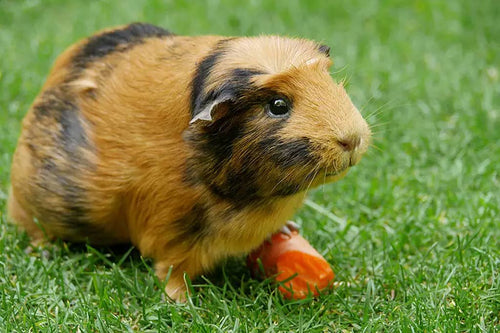
Guinea pigs are fun, quirky companions for people of all ages. Though small, these little animals have bags of character and very distinct, individual personalities.
If you’re thinking of bringing some guinea pigs into your home, you’ll be rewarded by conversational squeaks, affectionate nuzzling, and the comical sight of your pets devouring hay and vegetables like there’s no tomorrow. If you’re already an owner, then you’ll know firsthand what enjoyable and easy pets they are to look after.
Guinea Pigs in the Wild
Wild guinea pig species (like Brazilian guinea pigs) make their homes on grassy plains, where there is ample grass and other vegetation for them to feast on. They are herd animals, with groups usually consisting of a few females (called sows), a male (called a boar) and their young. This need for socialising means that they are most comfortable with members of their own species, so human owners of the domesticated species often keep them in pairs or threes.
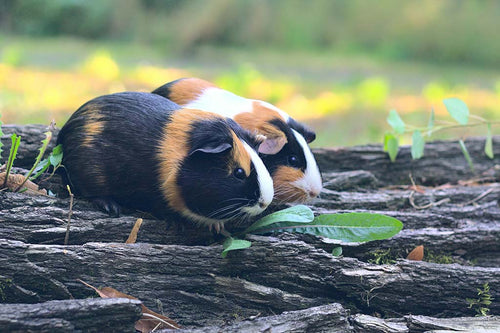
Unlike other rodents, guinea pigs don’t make their own burrows, preferring to hide from aerial predators under vegetation and within grass tunnels. Guinea pigs that are kept as pets today retain some of this fear of wide open spaces, so it's a good idea to offer them a small enclosed space into which they can run if they feel a little uneasy. Examples of this are hideaways, ramps and tunnels that you can put into your pets' run. (Links to sample products below)





Domestication

After being domesticated by Andean people, guinea pigs remained popular in the area for many thousands of years, and were extremely popular amongst the Incas.
There’s evidence to suggest that guinea pigs lived closely with these people, and that for many years they were often found living in and around people’s homes as livestock. The guinea pigs were a curiosity, and so after the Spanish discovered the region in the 1530s, several boats brought them back across to Europe. Soon they were being kept in a number of different countries, and their endearing nature and shape made them popular pets for the children of wealthy families.
Only the wealthy were able to afford guinea pigs at first - at the time they were a strange and exotic animal that would have cost a great deal of money to purchase and look after. Queen Elizabeth the First is thought to have been an early guinea pig owner, and during her reign they became fashionable throughout Britain. Today, they are relatively cheap, hold the title of one of the world’s most popular rodent pets, and come in many more colours than their wild ancestors would have originally been found in.
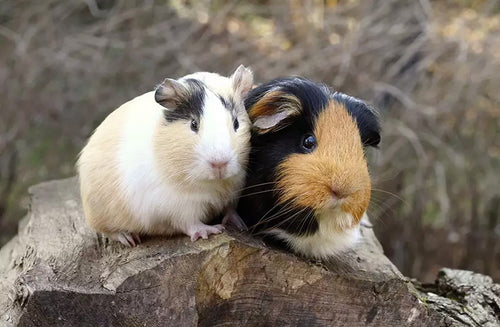
Anatomy
Here is their anatomy, from the top to somewhere near where the tail should be!
Eyes
The eyes are large and placed on either side of the head. They have a wide field of vision so that they can detect predators coming from above or from any angle on the ground. They are unable to see right in front of their noses though! Their sight is not particularly good, although they are believed to see different colours and are able to see moving objects.
Nose
Guinea pigs have a very well developed sense of smell, and they also have whiskers around their nose, eyes and mouth which are very sensitive to touch. The senses of smell and touch are very important when choosing food items because, due to their eye placement, they are unable to see what they eat. (Their favourite occupation is eating!)
Ears
The guinea pig has a very good sense of hearing, and can hear sound frequencies that are inaudible to the human ear. They can certainly hear you open the fridge door from their home in the garden!
Teeth
Guinea pigs have 20 teeth in total, but the ones you can see are the 4 incisors at the front of the mouth, 2 at the top and 2 at the bottom. These are used for gnawing and biting their food. The rest of the teeth in the back of the mouth are the molars, and these do the chewing. Guinea pigs chew with a side-to-side movement, and may make 200 of these movements every minute. A guinea pig is happiest when eating! The teeth are known as open-rooted, and grow all the time, but with all that eating and chewing they are constantly worn down.
Digestion
The guinea pig has a large digestive system to process all the food it loves to eat. First the food enters the stomach where it is mixed with digestive juices and any sugars and fat are absorbed by the intestines. Then the rest of the food passes into the caecum, which is a huge fermentation vat which takes up 50-75% of the space inside the guinea pigs abdominal cavity! Guinea pigs then produce two types of droppings, the hard ones which they leave around the cage for you to clear up, and soft ones known as caecotrophs which are full of protein and vitamins and these the guinea pig eats directly from its bottom. It may produce up to 150 of these caecotrophs to eat a day!
The Skeleton
Guinea pigs have a total of 258 bones in their body. There are 34 bones in the spinal cord, 43 in each front leg, 36 in each back leg and for you mathematicians the rest of the bones make up the skull, ribs and breastbone. Despite the number of bones in their legs, they do not jump or land very well, and a fall is likely to result in them breaking a leg, so they must always be held and carried very carefully.
The Tail
There are actually seven tail bones, but they are fused so closely to the bottom (pelvis) there is no recognisable tail on these little creatures.
Rough or Smooth?
There are now literally hundreds of different breeds of guinea pigs available. They are broadly divided into two groups, the smooth (or self varieties) and the rough (or non-self varieties).
Smooth-haired

As the name implies these are the ones with the short smooth coats. Within this category there are many different colours, all as individual breeds. For example there are self blacks, self creams, self whites (with pink albino eyes) and dark eyed whites. Also self reds, self chocolates, the list goes on. All these breeds can also come in a satin variety. A satin has a different type of hair that reflects light, giving it a shiny appearance.
Smooth cavies can also come in a mixture of colours. The agouti has a hair tip and root that are different colours (they look like someone who needs their roots re-coloured!) and are closest to the colour of their wild ancestors. Tortoiseshells have the colours red, white and black arranged in special blocks on their bodies, and Dalmations, like the dog of the same name, are white with black spots! Himalayans are marked like Siamese cats.
Rough-haired
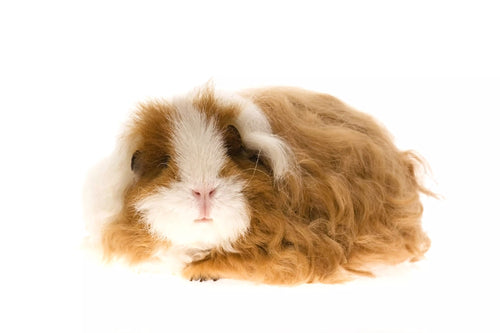
In this group we have the Peruvians, with long flowing coats of hair up to 20 inches long, and the Shelties with slightly finer coats. These are not breeds for the faint-hearted, but for people who are prepared to do a lot of grooming. Then there are Texels (Shelties with a perm!), Teddies and Rexes whose hair sticks straight out like a hedgehog. Then there are all the Crested varieties, smooth guinea pigs with a rosette or crest on their forehead. Shelties can have crests too, and then they are called Coronets. Abyssinians have rosettes all over, 10 in all, laid out in a special pattern over their bodies. All these varieties come in a multitude of colours as well.
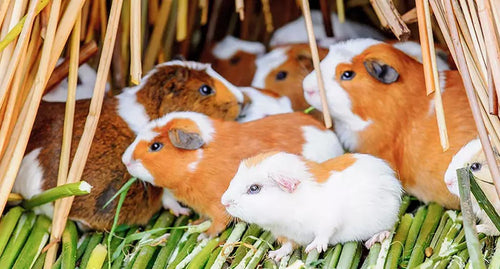
As you can see, there is a huge range of guinea pigs to choose from. Many others are crossbreds, mixtures of different breeds, and equally appealing.
Whatever type of guinea pig you choose, you can be guaranteed a friendly and entertaining companion, who will live for between 4-7 years of age.
